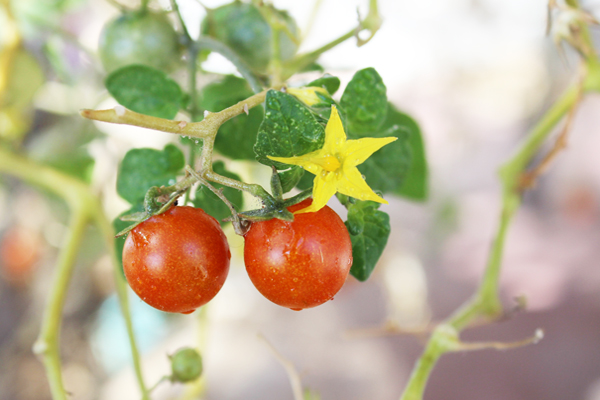It’s Tomato Time Tucson!
March brings with it warmer weather and a new planting season in the Old Pueblo. Some of our fellow gardeners have taken advantage of the unseasonably warm temperatures in February to get a head start on their spring crops. Others, like myself, all too weary of a late spring frost have resisted this temptation. Regardless of your risk tolerance, late February through March is the prime time to plant tomatoes.
Tomatoes are the bane of desert gardeners everywhere because all to often plants end up looking green and lush with little to no fruit to make the investment worth it. In my conversations with gardeners, I’ve learned that the majority of the time this outcome could have been avoided had a few initial steps been taken. By following these simple guidelines, your likelihood of producing a bumper crop in 2014 will be greater than ever.
Success with tomatoes all starts at the nursery or with the seed selection. Forget the monster Mortgage Lifter that may have won you the blue ribbon at the county fair back home. Large beefsteak type tomatoes do not grow well in our climate and will most likely split before they reach their full size. Conversely, smaller tomatoes do very well. Local seed source Native Seeds/SEARCH has many great heirloom varieties of cherry type and small tomatoes, including Flamenco, Punta Banda and Texas Wild Cherry.
There are some other important factors that you should consider when selecting tomatoes varieties to plant in the low desert. Tomato cultivars with shorter days to maturity or those have been bred for heat tolerance are also known to do well in our climate. Some good examples you’re likely to find include Yellow Pear, Cherokee Purple, Stupice and Pearson Improved. After you have chosen a suitable variety of the low desert, the next step is make sure you get your tomatoes planted at the right time.
The most common mistake Tucson gardeners make is waiting too long to plant their tomatoes in the ground. As a result, they get poor yields. Tomato seeds should be started indoors or in the green house starting in December and transplants should be planted outdoors starting in mid- to late-February and continuing through mid-March. If you wait much longer than this to get your tomatoes in the ground, your yield is likely to drop as hot temperatures set in—decreasing fruit production.
Unlike most garden transplants, tomatoes are planted in a trench rather than a hole. Trim your new tomato starts leaving only the top two sets of leaves. Dig a small trench one inch deep and the length of a stem with a hole on one side just large enough to accommodate the root ball of the transplant. Gently lay your new seedling in the trench and cover the entire stem leaving only the top two leaves exposed. Your plant will grow slowly over the next few weeks, but by planting this way a strong root system will develop rewarding you will better drought tolerance and more fruit production in the spring.
Because tomatoes are tropical plants that prefer warm temperatures planting them in the ground late in the winter can present some challenges. You must be prepared to care for your tender young seedlings if nightly temps drop to freezing levels. Small plants can be covered at night using a cloche made from home made materials such as an old milk jug or a 3 liter soda bottle. You can read more about how to protect your garden from frosty weather in the November issue of Zócalo Magazine.
As the season progresses and your plants continue to grow, you’ll want to care for them by applying organic fertilizers on a regular basis throughout the season. My favorite is Tank’s Green Stuff compost. Mix in generous helpings of compost to the soil at the beginning of the season before planting, and apply a two inch layer of compost mulch as the weather warms in April. Nutrients will be slowly released into the soil each time you water and the mulch will help to reduce watering needs during the summer. Tank’s compost, as well as tomato seedlings of some of the varieties discussed above can be purchased at Ecogro or Green Things Nursery.
Brandon Merchant is the proprietor of Southwest Victory Gardens. Visit his website at SouthwestVictoryGardens.com.
Category: Community, FOOD & DRINK, Nature





